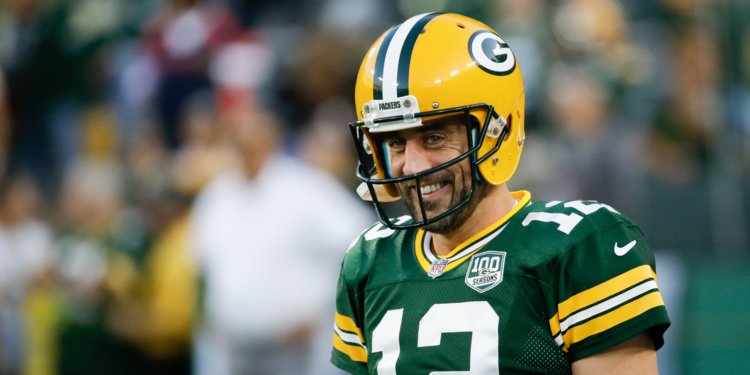How Aaron Rodgers Rose From The Ashes and Saved The NFL

By: Brady Gardner
As is the case at the beginning of any NFL season, the excitement among fans nationwide in anticipation of Week 1 is undeniable.
Millions have long awaited the return of professional football, and after an afternoon jam-packed with twelve fixtures ranging from electrifying upsets to impressive blowouts, all eyes are on NBC’s Sunday Night Football broadcast. The audience is ready for the grand finale, the fireworks show to conclude the fall’s first NFL Sunday.
Sunday Night Football is meant to be the game of the week; the matchup with the most history, the most storylines, and the most at stake. But the teams on the field aren’t the only ones with something on the table in this contest. For the NFL, hundreds of thousands of viewers will be gained or lost as a result of this telecast. A dud of a game could spell disaster for the league, triggering a drop in ratings and relevance that could last an entire season.
With so much in the balance, all would be decided in sixty minutes of football between the Green Bay Packers and the Chicago Bears.
As the Bears jumped out to an early lead against their NFC North rivals, the headlines were already writing themselves: “Bears upset Packers at Lambeau”. Nothing too special, but a fairly safe result for the NFL. Everything was looking alright for the league, until one broken play changed the game completely.
With just over nine minutes remaining in the second quarter, Packers quarterback Aaron Rodgers fell to the turf as his offensive line gave in to the Bears’ pass rush. The Packers had surrendered a sack, but this play was much more than simply a loss in field position.
Amidst the chaos of an effective Chicago blitz, a Bears defender dove on to the fallen quarterback, landing awkwardly on Rodgers’ left leg. The Packers’ star managed to limp off the field, but as he climbed gingerly in to the medical cart and was driven towards the locker room, NFL fans and executives alike feared the worst.
An injury to one of the true superstars of the league was the last thing the NFL needed to start their 2018 season. A collarbone fracture that forced Rodgers to miss half of 2017 campaign was just one of many injuries that forced stars to miss part if not all of the 2017 season, a list that included the likes of JJ Watt, David Johnson, Carson Wentz, and so many other standout players whose absences left an obvious mark on the quality of the league. The NFL cannot afford to have such bad luck for a second season in a row.
With a look of disappointment and despair, Rodgers disappeared into the tunnel, taking with him the allure of what was supposed to be a marquee matchup. Backup quarterback DeShone Kizer was no serviceable replacement for the two-time league MVP, a fact that was made apparent as Bears newcomer Khalil Mack stumbled into the endzone following a horrendous interception by Kizer that left every knowledgeable football fan scratching their heads.
With one the league’s most elite quarterbacks back in the locker room, this game was quickly becoming a nightmare for the NFL, a bust for the season’s first nationally-televised primetime broadcast.
Something needed to change, and it needed to happen fast.
Fortunately for the NFL, it did.
After a halftime healing that could only have been completed by Mr. Miyagi himself, Rodgers was back on the field. Although the Packers were still down 20-0, Rodger’s return in the same game was a major development, and certainly enough to resuscitate Packers fans who had expected their quarterback’s injury to be much more long-term.
And as far as the NFL was concerned, the league hadn’t lost a superstar after all. Their fears were alleviated, and Rodgers looked like he would be alright.
But Aaron Rodgers didn’t come back out to prove he was alright. He came back out to win.
Playing on virtually one leg, Rodgers eased his way back into the game, getting his team down the field late in the third quarter before settling for a field goal. The Packers were on the board, but they still trailed by seventeen points heading into the final fifteen minutes.
Rodgers wasn’t done yet.
With a 39-yard dime to Geronimo Allison that would have made Rodgers’ highlight reel regardless of the bum leg, the scoreline went from lopsided to respectable. Less than five minutes later, Rodgers finished off a surgical drive with a 12-yard touchdown for Devante Adams, and suddenly the Packers were within striking distance.
As the clock wound down towards the two-minute warning, Rodgers connected with Randall Cobb for a 75-yard catch and run touchdown to put the Packers ahead for good, capping off yet another stunning comeback and signature game-winning touchdown from Green Bay’s franchise quarterback.
Within hours, this game transformed from an underwhelming contest marred by a significant injury to Green Bay’s best player, to a thrilling, magnetizing, game-of-the-year candidate. What had looked to be a miserable failure for the NFL in the season’s first Sunday Night Football telecast had suddenly become a sixty-minute drama, starring a man who rose from the ashes to carry his team to victory.
Aaron Rodgers’ epic return saved the game for the Packers. It very well may have also saved their season, knowing that their superstar would not be sidelined due to injury like in years past.
But most significantly, Rodgers saved the NFL. He saved them from losing a star in the first week of the season, and saved them from a disaster of a primetime fixture.
The NFL needed a hero, and Aaron Rodgers delivered.